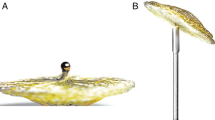Summary
The Rashkind-occluder was developed to close persistant ducts between the aorta and pulmonary artery. It is also usable to close small interatrial communications (atrial defect smaller than 5 mm in the septum secundum, persistant foramen ovale, fenestration after Fontan procedure). One of the indications for catheter interventional closure of such a small interatrial communication is the paradoxial embolism. The successfull implantation of a Rashkind-device prevents strokes or transient cerebral attacks and avoids longlife treatment with cumarin. We report about our experiences in the treatment of 26 patients with small interatrial communications. In 25 cases the small ASD or PFO were closed successfully by the Rashkind-occluder, 24 patients had a transient cerebral attack before the intervention treatment. We never saw any device-related late complications or further cerebral embolism. One early complication in a case with a 6 mm ASD with left-to-right shunting could be managed successfully in the heart cath.-laboratory. In our opinion the treatment of PFO with the Rashkind-occluder is a sure and good method to avoid further paradoxial embolism.
Zusammenfassung
Der für den katheterinterventionellen Verschluß des Ductus arteriosus persistens entwickelte Rashkind-Occluder eignet sich auch zum Verschluß kleiner Kommunikationen, speziell im Vorhofbereich (kleine ASD<5 mm, persistierendes Foramen ovale, operativ geschaffenes „Fenster“ als Überlaufventil bei der Fontan-Operation). Die Indikation zum Verschluß solch kleiner Defekte ist von der im Einzelfall vorliegenden Hämodynamik abhängig, eine sichere Indikation stellt die paradoxe Embolie dar. Wir berichten über unsere Erfahrung bei der katheterinterventionellen Behandlung kleiner Vorhofkommunikationen mit dem Rashkind-Occluder bei 26 Patienten, von denen 24 zuvor einen Schlaganfall oder eine transitorische ischämische Attacke erlitten hatten. Nach Ausschluß anderer Ursachen der zerebralen Mangeldurchblutung und Nachweis der Möglichkeit des Rechts-links-Shuntes auf Vorhofebene mit der transösophagealen Echokardiografie verschließen wir die atriale Kommunikation, um eine lebenslange Marcumarisierung der Patienten zu vermeiden. Keiner unserer Patienten hatte nach der Behandlung ein Schlaganfall- oder TIA-Rezidiv, Spätkomplikationen im Zusammenhang mit der Implantation des Rashkind-Occluders traten nicht auf.
Similar content being viewed by others
Author information
Authors and Affiliations
Additional information
Eingegangen: 15. April 1998 Akzeptiert: 29. April 1998
Rights and permissions
About this article
Cite this article
Gliech, V., Köhler, F. & Witte, J. Verschluß interatrialer Kommunikationen mit dem Rashkind-Doppelschirmchen bei Zustand nach paradoxer Embolie. Intensivmed 36, 62–66 (1999). https://doi.org/10.1007/s003900050211
Issue Date:
DOI: https://doi.org/10.1007/s003900050211




